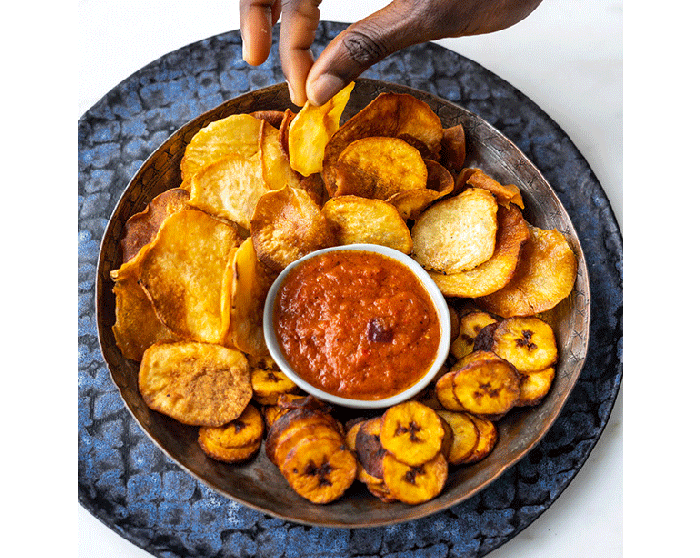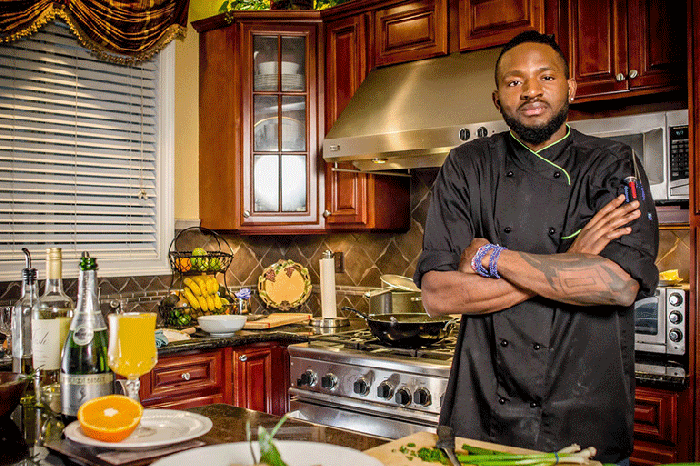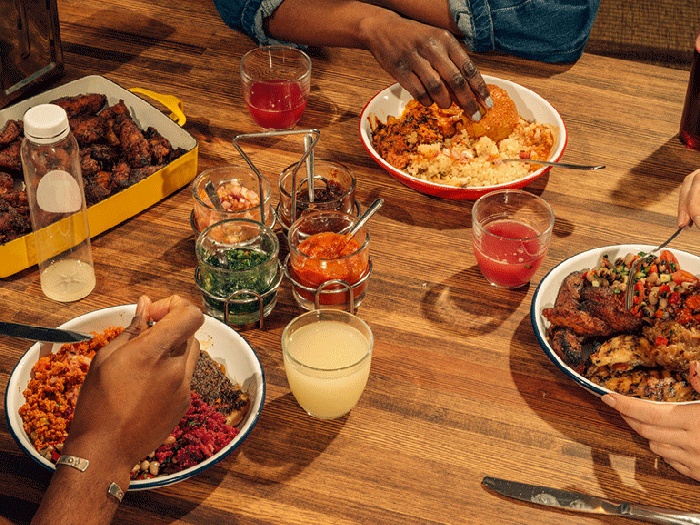Content Spotlight
Curry House Japanese Curry and Spaghetti has shuttered, closing all 9 units in Southern California
Employees learned of closure when arriving for work Monday
Dishes from Nigeria, Senegal, Liberia and elsewhere start to draw crowds

As Americans become increasingly adventurous in their culinary explorations, chefs have picked over much of the world to bring new flavor experiences to their customers. Until now, sub-Saharan Africa has been largely ignored, but that is changing as dishes such as jollof rice, suya and fufu begin to emerge on menus, driven largely by chefs eager to express their West African heritage.
The region stretching from Mauritania to Nigeria is home to rich stews, grilled meats and a wide range of vegetables and starches. It’s almost all gluten-free, and a lot of it is vegan.
“A lot of people are adventurous when it comes to food,” said Simileoluwa Adebajo, chef and owner of Èkó Kitchen, which she opened in San Francisco in May of 2019 after spending close to a year catering on weekends. Originally from Nigeria, Adebajo earned a master’s degree in international and developmental economics and was a financial analyst for the tech company called Twitch before opening her restaurant.

Eko Kitchen's sweet potato and plantain chips, smoked peppered goat meat with fried plantains and sweet potatoes, and whole grilled tilapia with roasted red pepper sauce and a grilled plantain.
“Eventually my passion project became my real thing,” she said.
She offers dishes such as Asun, which is smoked goat tossed in a sauce of bell peppers, tomato and onion, served with purple onion rings, fried plantains and fried white Japanese yams. As an occasional special she makes Ayamase, a specialty of her Yoruba ethnic group made by stewing “different parts of the cow,” including kidney, tripe and muscle meat in a blend of different types of green peppers cooked down in “bleached” palm oil — similar to clarified butter; the palm oil is heated until the solids separate out from it.
“Basically, the whole point is that you’re getting varied textures, but it’s still beef,” she said.
But her most popular dish is the Èkó Combo, which is grilled chicken in roasted red pepper sauce and fried plantain, served over jollof rice.
“I think what really appeals to people with that dish is the combination of bold flavors, but also spicy and sweet, which I think is a flavor profile that a lot of people don’t know they want to experience, and when they do, it’s like, ‘Wow!’”
Jollof rice is the common denominator of West African cuisine, served all over the region and made by cooking rice in a spiced sofrito of tomatoes, onions, bell peppers, chiles and a variety of herbs and spices such as thyme, bay leaves, garlic, ginger, curry powder and bouillon cubes (dried, processed ingredients including curry powder, garlic powder, bouillon cubes and Maggi sauce are widely used ingredients in West African cooking).
“In Nigeria we intentionally burn the rice [for jollof rice],” Adebajo said. She said the resulting smoky flavor and crunchiness is part of the dish’s appeal.
“That is a very hotly debated thing,” said culinary historian Michael Twitty, author of “The Cooking Gene: A Journey Through African American Culinary History in the Old South,” published by Harper Collins in 2017.
He said burnt jollof rice is a custom that’s unique to Nigerian cities.
“Some people’s jollof is very saucy, some people’s jollof is very dry, some people’s jollof has a crunchy outer ring on the bottom of the pot, some people’s jollof is very soft, or meaty, or seafood-y.”

Kith & Kin chef Kwame Onwuachi's monkfish egusi stew, cucumber and avocado, and charred brasicas and scallops.
Kwame Onwuachi, executive chef of Kith & Kin in Washington, D.C., makes his jollof rice in a red sauce called obe ata dindin, the Igbo name for a red stew made of red bell peppers, tomato, tomato paste, red onions, ginger, garlic, fermented habaneros and toasted curry powder, all cooked in palm oil.
Onwuachi draws on his own heritage, from Jamaica, Trinidad, New Orleans and Nigeria, at Kith & Kin, and sometime puts it in a mainstream American context. So he uses the obe ata dindin as the base of a Romesco sauce that flavors his dish of seared scallops and different varietals of cauliflower.
He also uses the spice blend normally used on a grilled, skewered meat snack called suya and cooks Brussels sprouts with it. That blend includes alligator pepper, chiles and peanut powder.
He also offers regular, beefy suya.
“There’s a whole [variety] of roasted and grilled meats, in pieces or whole, across West Africa, with a spicy seasoning or sauce,” said Twitty, adding that they’re usually cooked low and slow over hot smoke or smoky fires.
“That’s barbecue,” he said, and it’s one of many cooking approaches that American cuisine, particularly from the South, owes to West Africa, all imported as part of the slave trade.
That includes gumbo and okra stew, which is basically gumbo without the roux. Jambalaya, red rice and dirty rice are all descendants of jollof rice, Twitty said. And collard greens are a temperate reinterpretation of the stewed leaves of the cassava plant, called callaloo in Caribbean cooking, that originated in West Africa.
Of course, not all West African cuisine translates well to the American palate. Twitty said West Africans tend to ferment their starches by storing them in crocks or clay pots for one to four days, preserving them but also lending a funky quality that can be challenging to the uninitiated.
“That kind of sourish undercurrent is something that Africans are used to across the continent, and it’s not something that got passed down [to the United States],” Twitty said, largely because enslaved people didn’t have the time to make it.
Fermented locust bean is another common item that’s challenging to Westerners.
“It smells like socks,” Twitty said.
Preserved fish, found throughout West Africa, can be polarizing, too.
“If you’ve ever been on a plane from West Africa, in baggage claim the No. 1 smell that you get — everybody has brought back the stinking fish,” said Twitty, who often substitutes fish sauce for it when he’s cooking at home.

Chauncy Yarngo's leaf dip and cassava fries, plantain burger and cassava fries, duck confit, and fufu pizza.
Chauncy Yarngo, who moved to the United States from Liberia when he was 13 years old, runs a catering operation based in Minneapolis, and has been working hard to popularize his native cuisine since he was in culinary school in Virginia. Back then he asked an instructor why the school didn’t teach about African food.
“He told me ‘You wouldn’t be able to pay your student loan if you made African food,’” Yarngo said, because there wasn’t any demand for it.
After graduating, he tried to find American chefs who were making African food with a twist, “and I could not find that,” he said.
So he worked in nursing homes to learn to cook for people with special diets, and at the burger chain Red Robin to learn how to cook fast. He worked on a cruise line to learn how to make do with the ingredients he had on-hand, and in Mexican and Japanese restaurants to develop an understanding of those popular cuisines.
Now he prepares dishes like Cassava Wellington. For that dish he peels and boils cassava — a tuber that’s popular throughout West Africa — then grills it, and then finishes it steak-style in a sauté pan with butter, rosemary and garlic. He brushes it with Dijon mustard and wraps it, along with diced, sautéed mushrooms and callaloo sautéed with salt and lemon, in puff pastry and bakes it. He makes a spinach-like dip out of cassava leaves and uses the tuber — peeled, blanched, soaked in vinegar and fried — as the dipper for it.
He makes tacos for which he substitutes the tortillas with dried fufu — a gummy starch made in a variety of ways throughout West Africa, sometimes with cassava, and sometimes with sweet potatoes or plantains or other roots.
Another favorite dish of his is catfish that he marinates in a blend of dehydrated okra masked with honey, oregano, thyme, Scotch bonnet peppers and other seasonings, and then stuffs it with cilantro, onions and jalapeños. He grills that and serves it with a sauce of sautéed ginger, thyme, oregano and other seasonings in coconut milk.
Yarngo said he veers away from Liberian tradition by not using bouillon cubes or Maggi sauce.
“You don’t get to control your food’s flavor” with those items, he said. “The company that made the cube controls how your food ends up at the end of the day.”
Adebajo of Èkó Kitchen said she tries to keep the flavors at her restaurant as true to Nigerian cuisine as possible, albeit while toning down the chile, “because Nigerians love super-spicy food.”
At first, she tried to tone down some of the other flavors to appeal to the palates of the 70% of her customers who aren’t Nigerian, “But at some point I realized also that people were coming for an authentic experience. So if you’re not giving them the authentic experience, then why are they coming anyway? They can just buy some frozen product and microwave it at home. So I decided just to make it exactly the way my mom or my grandma would make it.”
She doesn’t hesitate to put fermented locust bean in her ayamase.
“It has a unique but intense flavor,” she said. “People always ask, ‘What am I tasting?’ They can’t compare it to anything else.”

Teranga's shared meal, yassa yassa season bowl, and fufu by hand.
At Teranga, a fast-casual West African restaurant that opened in New York City in February of 2019, the goal is not just to teach their customers about West African flavors, but the names, too, said Noah Levine, who co-founded the restaurant with chef Pierre Thiam.
“Pierre likes to say if people can learn ‘teriyaki,’ they can learn ‘jollof’ or ‘ndambe’ or ‘kelewele’,” Levine said.
Ndambe — pronounced en-DAM-bay — is a stew of sweet potatoes and black-eyed peas. Kelewele — KEL-ay WELL-ay — is spicy fried plantains.
Teranga has a bowl-like format, with a choice of three bases — the West African grain fonio, Liberian red rice and attieke (a-CHAY-kay) or fermented cassava couscous — topped with salmon or chicken or such vegan options as beet-fonio salad; black-eyed pea salad with cucumber, tomato, pepper and parsley in lime-ginger dressing; Calamance Salad, from southern Senegal, made with watercress, watermelon, mango, tomato, suya-spiced cashew and a vinaigrette made from a West African fruit leaf called moringa; or plantain fufu made with palm oil.
“We’re slowly unrolling different dishes, and as we grow, the funkier we’ll get,” Levine said.
Teranga is located in the Africa Center, a new educational space in Harlem, but it has two more locations planned later this year — one in an as-yet-undisclosed location in New York and another at the Dekalb Market Hall in Brooklyn, N.Y.
“What I love most about this place is that people can walk in and have a great meal, but also learn a bit about the food and maybe realize that they’ve been influenced by African cuisine, cooking styles, ingredients, and they haven’t even known it,” Levine said.
Contact Bret Thorn at [email protected]
Follow him on Twitter: @foodwriterdiary
You May Also Like